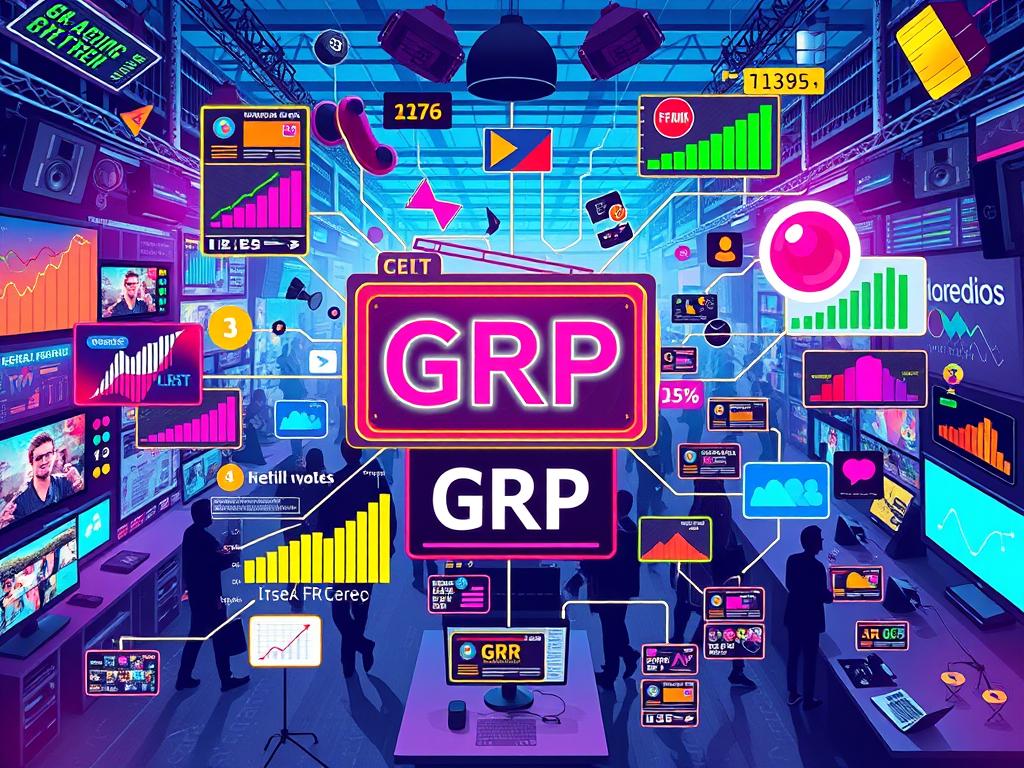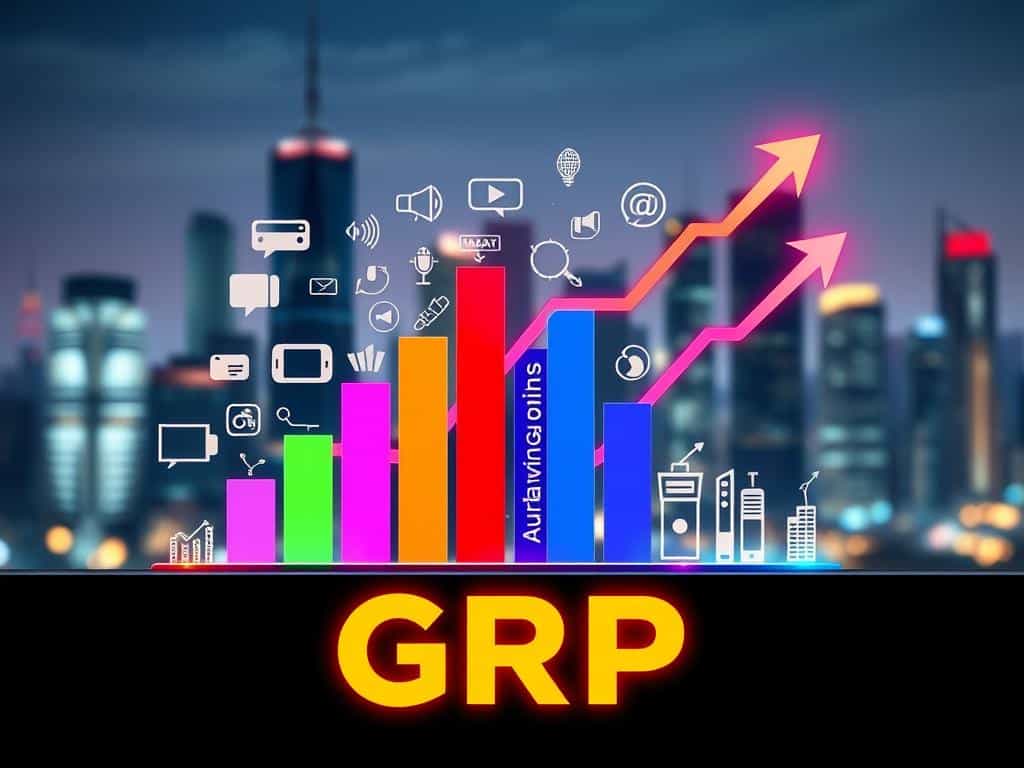Gross Rating Points (GRPs) stand as one of the essential advertising metrics you need to understand when delving into media planning and media buying. Developed in the 1950s, GRPs have been a cornerstone in television advertising, effectively quantifying ad impressions as a percentage of the target audience.
Essentially, GRPs measure the reach and frequency of your advertising campaign, providing a numerical value that reflects the size of the audience impacted by the ad. For instance, if an advertisement is displayed once to an entire market population, it amounts to 100 GRPs. Conversely, if your campaign ensures that 50% of the market sees your ad twice, that also equals 100 GRPs.
These advertising metrics play a pivotal role in measuring and evaluating campaign effectiveness. By leveraging GRPs, you’ll be better equipped to coordinate cross-media campaigns, set realistic market reach goals, and allocate your ad spend efficiently. Because balancing reach and frequency is crucial, GRPs help ensure that your ads make a lasting impression on your target audience, whether through television or digital platforms.
As you navigate the complex landscape of modern advertising, understanding and utilizing Gross Rating Points will remain an indispensable part of your toolkit, helping you make informed decisions that drive successful campaigns.
Understanding Gross Rating Points (GRPs)
Gross Rating Points (GRPs) serve as an essential measure of advertising exposure, aiding media buyers in evaluating return on investment by disclosing the percentage of a target audience that may have seen a particular ad. They can be likened to the concept of impressions or reach in the digital advertising realm. Despite the inability of GRPs to quantify the direct effectiveness of an ad campaign or its contribution to sales, they offer critical guidance for media planners in choosing the most advantageous times and channels for ad placement.
GRPs are calculated by multiplying the reach of an ad campaign (the percentage of the target population reached) by the average frequency, or number of impressions per viewer. For instance, targeting men aged 20-50 who watch the History Channel on Saturday mornings, where 60% of this demographic sees the ad three times, results in a GRP of 180 (60 x 3).
Advertisers aim to reach between 50% to 90% of their target market, with at least three exposures to prompt action. Audience measurement tools like Nielsen are commonly used to estimate the total viewing audience and specific demographic viewership for channels and shows. Although factors such as market size, timing of ad placement, and competition influence GRP calculations, they provide a comparable scale for assessing advertising impact across different media formats, including TV and digital platforms.
A higher GRP usually implies a higher cost for ad space but also indicates greater media exposure within the target market. By assessing GRP in relation to total campaign cost, advertisers can determine the effectiveness of different platforms and mediums for their advertising efforts. This helps bridge the gap between traditional and digital media, offering a comprehensive view of campaign effectiveness.
Importance of GRP in Media Planning
Gross Rating Points (GRPs) are essential in media planning as they help advertisers maximize audience reach and allocate ad spend effectively. By doing this, you can ensure the advertising campaign achieves optimum reach levels and audience engagement across various platforms.

Maximizing Reach
Maximizing reach is crucial for any advertising campaign. GRPs offer a numerical value that reflects the percentage of the target market reached and the frequency of exposure. For instance, with a $70 billion annual spend on U.S. TV advertising, reaching 40 percent of a specific demographic for a particular show can be a significant achievement. Nielsen estimates viewership using data from a panel of 40,300 households, representing 0.03 percent of all American TV households. By using GRPs, strategic planning for media channels becomes more precise, contributing to higher advertising effectiveness and audience engagement.
Allocating Ad Spend
When it comes to budget allocation, GRPs provide a clear metric to assess the campaign’s performance. For example, if an advertisement reaches 50% of the target audience and is seen four times on average, it achieves a GRP of 200 (50% × 4). This helps media strategists determine where to invest to maximize returns. Different media channels, like Hulu’s streaming platforms or traditional TV advertising, can be compared using GRPs to see where the money is best spent. By integrating GRPs into your media strategy, you ensure that you get the best possible results by effectively reaching and engaging your audience while maintaining high advertising effectiveness.
How GRP Is Calculated
Gross Rating Points (GRPs) are pivotal in advertising analysis as they quantify the total exposure of a campaign within a target audience. By understanding the individual components—reach and frequency—marketers can derive actionable insights into their media metrics, optimize their strategies, and measure audience penetration effectively.
Reach
Reach represents the percentage of the target audience that sees an advertisement at least once over the campaign period. This metric is crucial for evaluating media metrics as it shows the extent of audience penetration achieved. For instance, if a TV ad reaches 20% of its intended market, this percentage directly influences the GRP calculation.
Frequency
Frequency measures the average number of times an ad is viewed by the targeted audience. High frequency means repeated exposures to the same ad, potentially leading to increased brand recognition but also implying higher costs. The balance between reach and frequency is vital for efficient advertising analysis.
GRP Formula
The GRP formula is straightforward: GRP = Reach (%) x Frequency. For example, if a campaign reaches 20% of its target audience and the ad is viewed an average of five times, the GRP would be 100. This calculation aids advertisers in comparing the efficiency of different media channels and planning future campaigns to optimize both reach and frequency.
Understanding the calculation of GRPs assists marketers in making data-driven decisions. In digital marketing, incorporating GRPs alongside other modern metrics can significantly enhance advertising analysis and audience penetration, contributing to improved return on investment and campaign effectiveness.
What Is GRP In Advertising
Gross Rating Point (GRP) measures the size of an audience reached by a specific medium or ad campaign. Traditionally used in television advertising, GRP is calculated by multiplying the percentage of the target audience reached by the frequency of the ad. For example, if a campaign reaches 50% of its target audience and runs ten times, the GRP would be 500 (50 x 10).

GRPs help advertisers understand the reach and frequency of media efforts, enabling comparisons across different media platforms. This comparison is crucial for evaluating the cost-effectiveness of advertising on various platforms and assessing campaign performance on a larger scale. As explained in this GRP overview, GRPs are instrumental in measuring the impact of an ad campaign on the target audience.
GRP, by definition, quantifies impressions as a percentage of a target audience, multiplied by the frequency of the audience seeing the ad. Since the 1950s, GRPs have been the primary metric for TV advertising buys. However, in today’s multi-channel environment, GRPs serve as a bridge between traditional and digital media for major brands that require multi-channel exposure.
For instance, advertisers should aim to reach between 50% and 90% of their target market with at least three exposures to encourage viewer action. This metric helps in determining the required ad frequency, which varies with new, complex, or competitive products needing even higher frequency. Thus, GRPs prove invaluable in coordinating advertising campaigns across numerous platforms and calculating the required exposure to influence target demographics effectively.
Differences Between GRP and TRP
Understanding the difference between GRP and TRP is crucial for advertisers aiming for advertising precision. Both metrics provide valuable insights into the effectiveness of marketing campaigns, but their applications are distinct.
Target Rating Points (TRPs)
TRPs refine the concept of GRPs by focusing on audience specificity. While GRPs measure the percentage of the total audience exposed to an advertisement, TRPs specifically measure the exposure within a targeted demographic. This allows advertisers to concentrate their efforts on the most relevant segments, enhancing the effectiveness of targeted media buys.
Comparing GRP and TRP
When comparing GRP and TRP, one must consider the overarching difference in their application. GRPs provide a broad measure of overall reach across the entire audience. In contrast, TRPs hone in on reach within a specified demographic.
- Calculation: GRPs are calculated by multiplying the percentage of the total audience reached by the frequency of exposure. TRPs are determined by multiplying the percentage of the targeted audience reached by the frequency.
- Usage: GRPs are useful for understanding the total market impact, while TRPs offer insights into how well an advertisement performs within a specific group.
- Example: For a fast-food chain targeting young adults near college campuses, the GRP might be 900, but the TRP could be 540, showing the precise impact within the chosen demographic.
In conclusion, leveraging both metrics allows for a dual approach, combining broad market coverage with demographic focus. This dual measurement strategy aids in refining ad campaigns for maximum reach and efficiency, ensuring that media buys are not only extensive but also pinpointed for audience precision.
Applications of GRP in Digital Marketing
In the evolving landscape of digital marketing, Gross Rating Points (GRPs) have seamlessly integrated traditional and digital media, enhancing the efficiency of multi-channel strategies. GRPs transcend their original use in traditional advertising, offering a valuable metric for measuring the audience reach and frequency across various digital platforms.
Combining Traditional and Digital Media
GRPs play a crucial role in combining traditional and digital media to create a multi-channel strategy that leverages the strengths of both formats. By using GRPs, advertisers can ensure that their campaigns maintain a consistent audience reach across television, online video, social media, and other channels. This fusion allows for a cohesive measurement of a campaign’s overall impact, ensuring that no audience segment is left untapped.
The integration of traditional and digital media through GRP calculations provides a holistic view of an advertising campaign. Digital advertising analytics can further dissect these GRP data to optimize performance, making sure each component of the media plan is effective.
Assessing Cross-Channel Performance
When it comes to cross-channel performance, GRPs offer unparalleled insights into the effectiveness of various channels. Understanding how to measure GRPs in both traditional and digital realms enables advertisers to evaluate the overall success of their campaigns. By employing a multi-channel strategy, you can gauge which channels contribute most significantly to audience reach and engagement.
| Channel | GRP | Audience Reach (%) | Frequency |
|---|---|---|---|
| Television | 8.5 | 45% | 4 |
| Online Video | 5.2 | 25% | 3 |
| Social Media | 4.6 | 20% | 2 |
Through such detailed breakdowns, digital advertising analytics help refine strategies, allocating advertising budgets more effectively. This aids in crafting campaigns with optimal audience reach and engagement, ensuring each media channel brings value to the overall marketing goals.
Factors Influencing GRP
Understanding the key factors that influence Gross Rating Points (GRP) allows advertisers to optimize their media strategies effectively. These factors encompass market size, target audience identification, and ad frequency. By delving deeper into each element, advertisers can maximize their advertising reach and precision in media buys.
Market Size
Market size plays a pivotal role in determining the potential reach of an advertising campaign. The total number of potential viewers or consumers within a given area can influence the GRP significantly. Advertisers often aim for a GRP between 100 and 200 to ensure effective reach, though this can vary depending on the objectives and scope of the campaign.
Target Audience
Demographic targeting is essential for creating impactful advertising campaigns. A well-defined target audience allows advertisers to tailor their messages to specific groups, enhancing the relevance and effectiveness of the ads. Platforms like Facebook and YouTube utilize sophisticated demographic targeting tools, providing accurate GRP comparisons between digital and traditional TV advertisements, thereby optimizing ad impressions.
Ad Frequency
The frequency of advertisements directly correlates with their impact. In traditional TV advertising, achieving a balance between reach and frequency is crucial. Ideally, a campaign should aim for a reach of 50-90% of the target market, with viewers being exposed to the ad at least three times for optimal effect. In digital marketing, combining GRP with other metrics like CPM, CTR, and conversion rates can offer a more comprehensive analysis of campaign effectiveness, ensuring that the right message is delivered to the right audience at the right time.
By understanding these factors, advertisers can make informed decisions about their media buys, improve their advertising reach, and ensure the success of their campaigns across various platforms.
How Does PMP Relate to GRP in Advertising?
PMP and GRP are essential terms in modern advertising strategies. Pmp meaning in advertising refers to Private Marketplace deals, ensuring targeted ad placements, while GRP measures the audience reach of a campaign. Together, they optimize ad impact, combining precise targeting through PMP with GRP’s focus on broad exposure to maximize campaign effectiveness.
Conclusion
In wrapping up, it’s clear that Gross Rating Points (GRPs) play a pivotal role in advertising success, providing marketers with the means to measure the impact and reach of their campaigns effectively. By understanding and calculating GRPs, you can gain valuable campaign insights that guide precise media planning and optimization strategies.
Throughout this article, we’ve delved into the importance of GRPs, how they are calculated, their application in both traditional and digital media, and the various factors that influence them. From maximizing reach and allocating ad spend to understanding the differences between GRP and TRP, each component contributes to a more comprehensive grasp of media planning effectiveness.
By leveraging tools like market studies, audience measurement, and data from sources like Nielsen, advertisers can fine-tune their strategies to reach their target market efficiently. While GRPs offer a unified metric for comparing campaign success across different media types, it’s essential to complement them with alternative metrics like CTR and conversion rates for a well-rounded picture of your campaign’s performance.
Ultimately, integrating GRPs into your media planning process not only enhances the precision of your campaigns but also enables real-time adjustments that drive a higher return on investment. Whether you’re focusing on traditional or digital platforms, GRPs provide the foundational framework for achieving advertising success and improving overall brand visibility.







